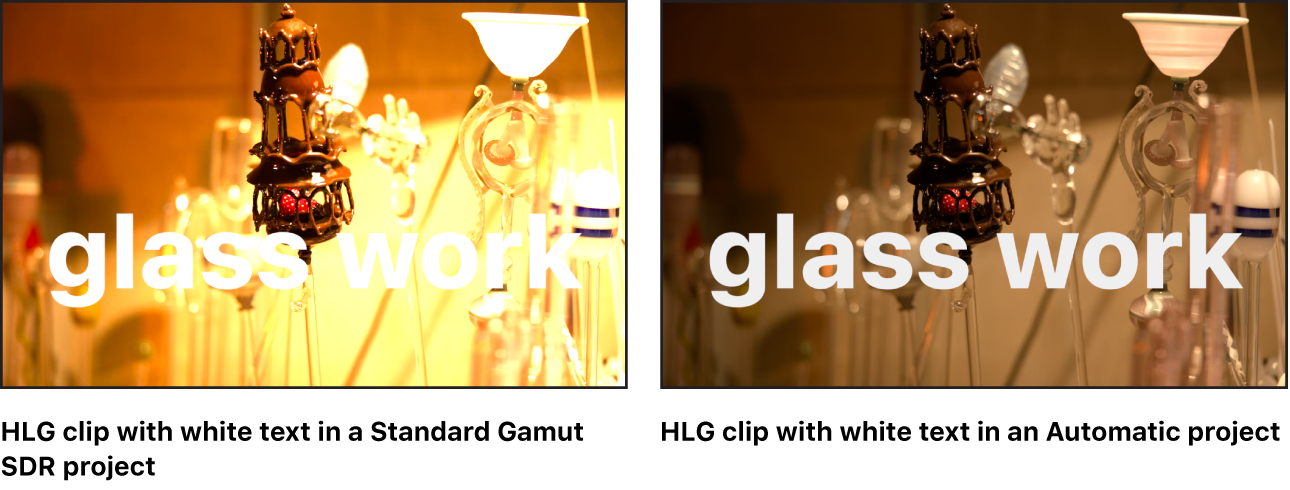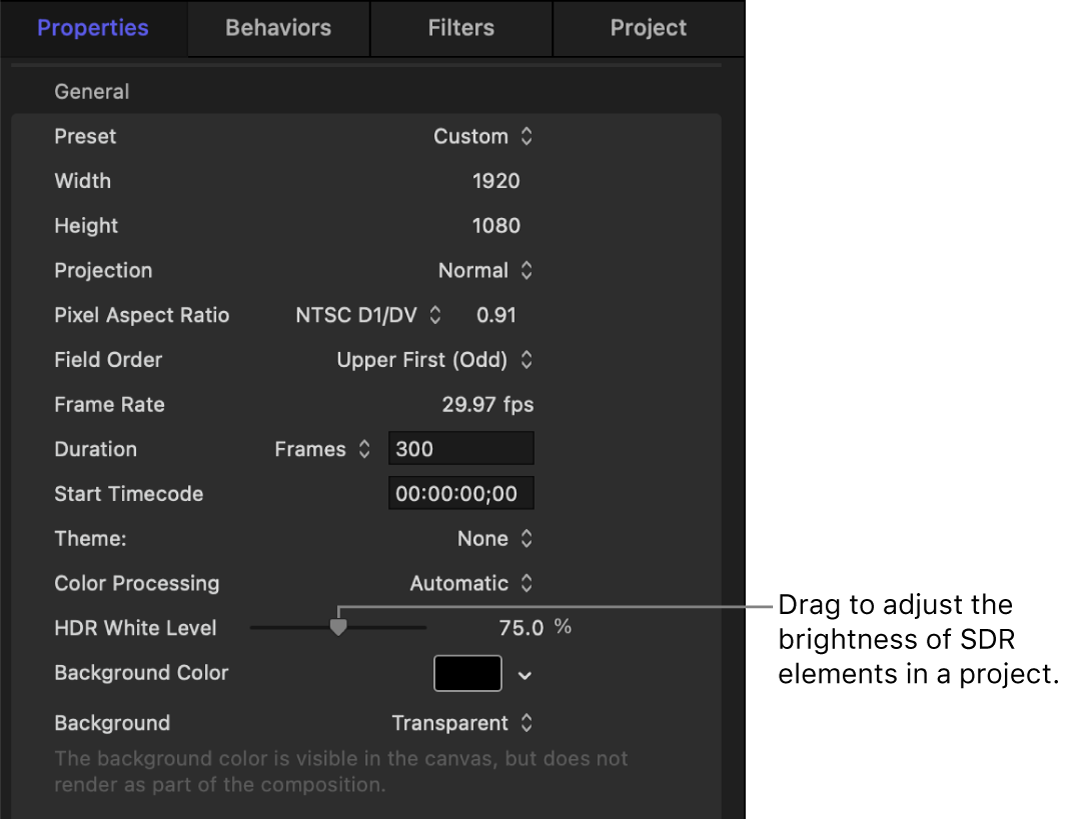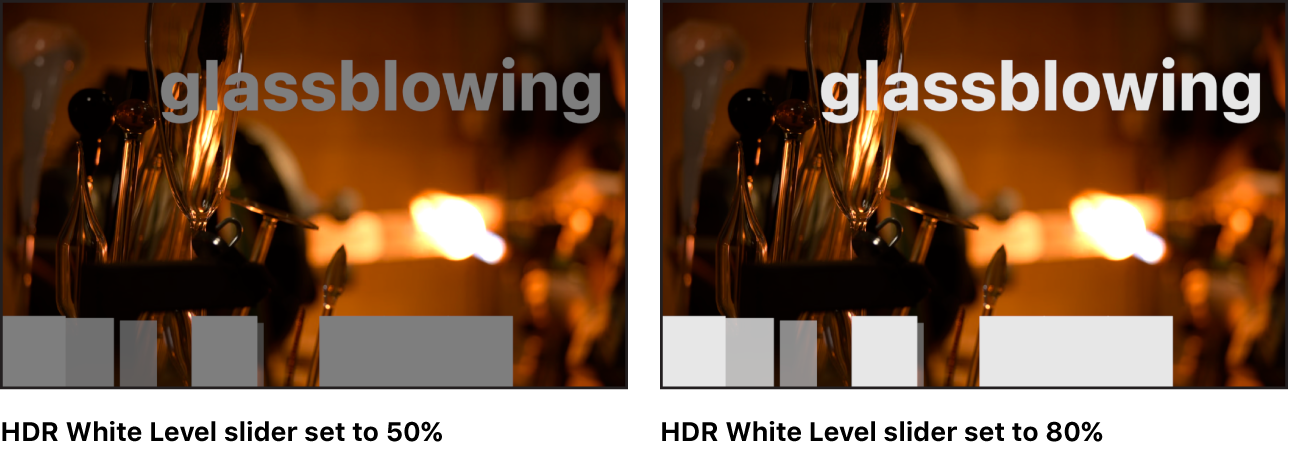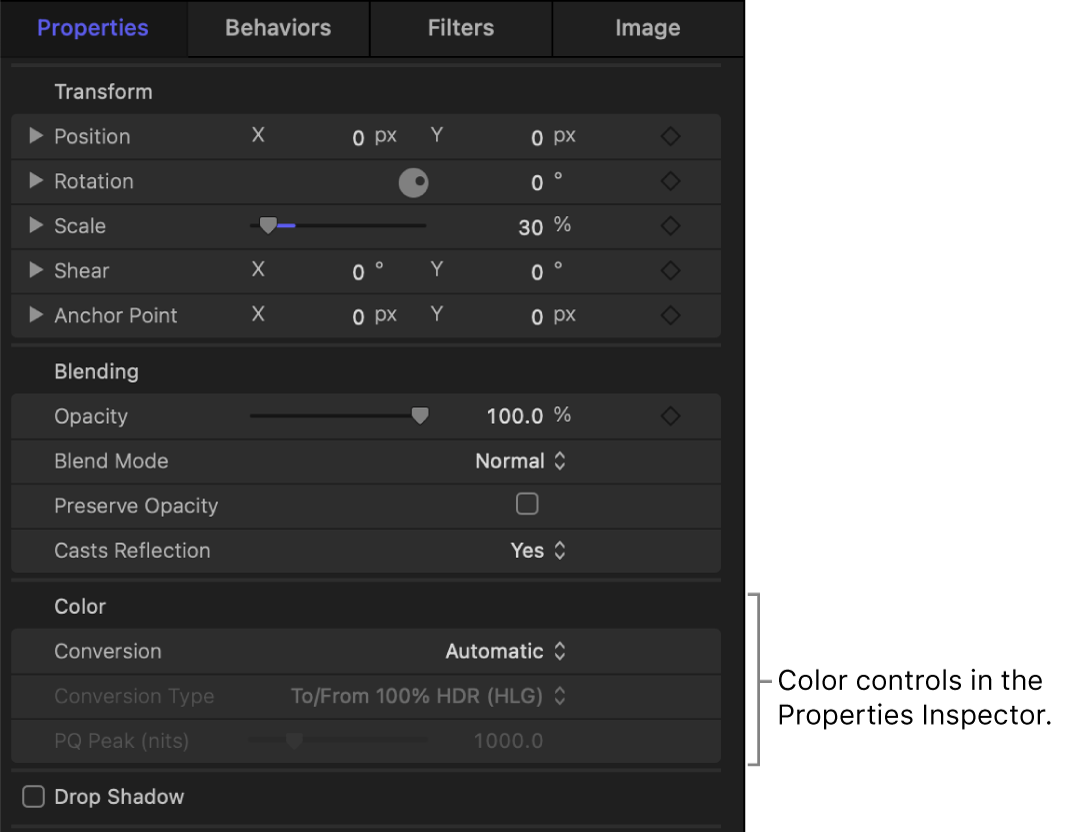Motion User Guide
- Welcome
- What’s new
-
- Intro to basic compositing
-
- Intro to transforming layers
-
- Intro to transforming layers in the canvas
- Transform layer properties in the canvas
- Transform tools
- Change layer position, scale, or rotation
- Move a layer’s anchor point
- Add a drop shadow to a layer
- Distort or shear a layer
- Crop a layer
- Modify shape or mask points
- Transform text glyphs and other object attributes
- Align layers in the canvas
- Transform layers in the HUD
- Transform 2D layers in 3D space
-
- Intro to behaviors
- Behaviors versus keyframes
-
- Intro to behavior types
-
- Intro to Parameter behaviors
- Audio behavior
- Average behavior
- Clamp behavior
- Custom behavior
- Add a Custom behavior
- Exponential behavior
- Link behavior
- Logarithmic behavior
- MIDI behavior
- Add a MIDI behavior
- Negate behavior
- Oscillate behavior
- Create a decaying oscillation
- Overshoot behavior
- Quantize behavior
- Ramp behavior
- Randomize behavior
- Rate behavior
- Reverse behavior
- Stop behavior
- Track behavior
- Wriggle behavior
-
- Intro to Simulation behaviors
- Align to Motion behavior
- Attracted To behavior
- Attractor behavior
- Drag behavior
- Drift Attracted To behavior
- Drift Attractor behavior
- Edge Collision behavior
- Gravity behavior
- Orbit Around behavior
- Random Motion behavior
- Repel behavior
- Repel From behavior
- Rotational Drag behavior
- Spring behavior
- Vortex behavior
- Wind behavior
- Additional behaviors
-
- Intro to using generators
- Add a generator
-
- Intro to image generators
- Caustics generator
- Cellular generator
- Checkerboard generator
- Clouds generator
- Color Solid generator
- Concentric Polka Dots generator
- Concentric Shapes generator
- Gradient generator
- Grid generator
- Japanese Pattern generator
- Lens Flare generator
- Manga Lines generator
- Membrane generator
- Noise generator
- One Color Ray generator
- Op Art 1 generator
- Op Art 2 generator
- Op Art 3 generator
- Overlapping Circles generator
- Radial Bars generator
- Soft Gradient generator
- Spirals generator
- Spiral Drawing generator
- Use Spiral Drawing onscreen controls
- Star generator
- Stripes generator
- Sunburst generator
- Truchet Tiles generator
- Two Color Ray generator
- Save a modified generator
-
- Intro to filters
- Browse and preview filters
- Apply or remove filters
-
- Intro to filter types
-
- Intro to Color filters
- Brightness filter
- Channel Mixer filter
- Color Adjustments filter
- Color Balance filter
- Example: Color-balance two layers
- Color Curves filter
- Use the Color Curves filter
- Color Reduce filter
- Color Wheels filter
- Use the Color Wheels filter
- Colorize filter
- Contrast filter
- Custom LUT filter
- Use the Custom LUT filter
- Gamma filter
- Gradient Colorize filter
- HDR Tools filter
- Hue/Saturation filter
- Hue/Saturation Curves filter
- Use the Hue/Saturation Curves filter
- Levels filter
- Negative filter
- OpenEXR Tone Map filter
- Sepia filter
- Threshold filter
- Tint filter
-
- Intro to Distortion filters
- Black Hole filter
- Bulge filter
- Bump Map filter
- Disc Warp filter
- Droplet filter
- Earthquake filter
- Fisheye filter
- Flop filter
- Fun House filter
- Glass Block filter
- Glass Distortion
- Insect Eye filter
- Mirror filter
- Page Curl filter
- Poke filter
- Polar filter
- Refraction filter
- Ring Lens filter
- Ripple filter
- Scrape filter
- Sliced Scale filter
- Use the Sliced Scale filter
- Sphere filter
- Starburst filter
- Stripes filter
- Target filter
- Tiny Planet filter
- Twirl filter
- Underwater filter
- Wave filter
-
- Intro to Stylize filters
- Add Noise filter
- Bad Film filter
- Bad TV filter
- Circle Screen filter
- Circles filter
- Color Emboss filter
- Comic filter
- Crystallize filter
- Edges filter
- Extrude filter
- Fill filter
- Halftone filter
- Hatched Screen filter
- Highpass filter
- Indent filter
- Line Art filter
- Line Screen filter
- MinMax filter
- Noise Dissolve filter
- Pixellate filter
- Posterize filter
- Relief filter
- Slit Scan filter
- Slit Tunnel filter
- Texture Screen filter
- Vignette filter
- Wavy Screen filter
- About filters and color processing
- Publish filter controls to Final Cut Pro
- Using filters on alpha channels
- Filter performance
- Save custom filters
-
- Intro to 3D objects
- Add a 3D object
- Move and rotate a 3D object
- Reposition a 3D object’s anchor point
- Exchange a 3D object file
- 3D object intersection and layer order
- Using cameras and lights with 3D objects
- Save custom 3D objects
- Guidelines for working with 3D objects
- Working with imported 3D objects
-
- Intro to 360-degree video
- 360-degree projects
- Create 360-degree projects
- Add 360-degree video to a project
- Create a tiny planet effect
- Reorient 360-degree media
- Creating 360-degree templates for Final Cut Pro
- 360-degree-aware filters and generators
- Export and share 360-degree projects
- Guidelines for better 360-degree projects
-
- Intro to settings and shortcuts
-
- Intro to Keyboard shortcuts
- Use function keys
- General keyboard shortcuts
- Audio list keyboard shortcuts
-
- Tools keyboard shortcuts
- Transform tool keyboard shortcuts
- Select/Transform tool keyboard shortcuts
- Crop tool keyboard shortcuts
- Edit Points tool keyboard shortcuts
- Edit shape tools keyboard shortcuts
- Pan and Zoom tools keyboard shortcuts
- Shape tools keyboard shortcuts
- Bezier tool keyboard shortcuts
- B-Spline tool keyboard shortcuts
- Paint Stroke tool keyboard shortcuts
- Text tool keyboard shortcuts
- Shape mask tools keyboard shortcuts
- Bezier Mask tool keyboard shortcuts
- B-Spline Mask tool keyboard shortcuts
- Transport control keyboard shortcuts
- View option keyboard shortcuts
- HUD keyboard shortcuts
- Inspector keyboard shortcuts
- Keyframe Editor keyboard shortcuts
- Layers keyboard shortcuts
- Library keyboard shortcuts
- Media list keyboard shortcuts
- Timeline keyboard shortcuts
- Keyframing keyboard shortcuts
- Shape and Mask keyboard shortcuts
- 3D keyboard shortcuts
- Miscellaneous keyboard shortcuts
- Touch Bar shortcuts
- Move assets to another computer
- Work with GPUs
- Glossary
- Copyright

Manage automatic color processing in Motion
When a project contains a mixture of SDR elements created in Motion (such as text, shapes, or generators), SDR media, and HDR media, use Automatic color processing to have Motion manage your project’s color space. Automatic color processing uses intelligent tone mapping to integrate media elements with varying color spaces.
The left image below shows a project with Color Processing set to Standard Gamut SDR; the project contains white text superimposed over an HLG video clip. Because the dynamic range of both text and clip is uncorrected, the clip appears blown out, and the white text appears too bright. In the right image, Color Processing is set to Automatic. Because the elements are now automatically tone mapped, the clip appears accurate and the text is better integrated with the image.

When a project’s Color Processing is set to Automatic, the following occurs:
The project’s render color space is automatically determined by your computer display. With an SDR display, the Render Color Space setting (in the View pull-down menu) is set to Rec. 709. With an HDR display, the Render Color Space setting is set to HDR Rec. 2020 HLG.
All images or clips in the project are automatically converted to the project’s working color space. When necessary, inverse tone mapping is applied to SDR elements to expand their range of brightness, and tone mapping is applied to HDR elements to narrow their range of brightness.
Changing the render color space lets you preview how your project will look when exported to a movie file (or, if it’s a Final Cut effect, generator, transition, or title, how it will appear when it’s applied to the Final Cut Pro timeline).
An HDR White Level slider becomes available, letting you adjust the brightness of SDR elements in a project.
A Final Cut effect, transition, title, or generator template automatically conforms to the color space of the Final Cut Pro project when the template is applied to the timeline. Additionally, you can publish the HDR White Level slider with the template, allowing Final Cut Pro users to adjust the brightness of any SDR elements in the template.
Additional color controls become available in the Properties Inspector to override the automatically assigned conversion type of an image or clip.
Adjust the brightness of SDR elements
When a project’s Color Processing is set to Automatic, you can adjust the brightness levels of SDR elements (such as images, titles, shapes, and other graphics created in Motion) to better match the brighter levels of HDR media.
In a Motion project, set Color Processing to Automatic and set Render Color Space to HDR Rec. 2020 HLG or HDR Rec. 2020 PQ.
In the Layers list, select the Project object (or press Command-J).
In the Properties Inspector, drag the HDR White Level slider to increase or decrease the brightness of any SDR elements in the project.

Adjusting the HDR White Level slider affects all SDR elements in the project. If you don’t want the slider to affect a certain SDR image or clip, you can change its conversion type (see Change the automatic color conversion type for an image or clip).

Note: In general, the HDR White Level slider has no effect on HDR media. However, when you apply a filter that contains a color well (with the exception of Color Balance) to an HDR image or clip, the HDR image may be affected by the HDR White Level slider. See About filters and color processing.
Change the automatic color conversion type for an image or clip
When a project’s Color Processing is set to Automatic, Motion adjusts the dynamic range of an image or clip to better match the project’s Render Color Space setting (in the View pull-down menu) using different conversion types. If necessary, you can choose another conversion type.
In a Motion project, set Color Processing to Automatic.
In the Layers list, select the image or clip whose color conversion type you want to modify.
In the Properties Inspector, move the pointer over the end of the Color row, then click Show.

Click the Conversion pop-up menu, then choose Manual.
Click the Conversion Type pop-up menu, then choose one of the following:
To/From 100% HDR (HLG): Converts a clip to or from 100% of the HDR HLG dynamic range whenever the clip needs to be tone mapped. For example, if the Render Color Space is set to Rec. 709, the full dynamic range of HLG is tone mapped to the full (but more limited) dynamic range of SDR, resulting in an HLG image that appears correct in the project. If the Render Color Space is set to HDR Rec. 2020 HLG, the full (but limited) dynamic range of Rec. 709 is inverse tone mapped to the full dynamic range of HLG. (If the clip is HLG and the render color space is set to HDR Rec. 2020 HLG, then no conversion occurs.)
In general, use this option when your SDR media needs to expand to the maximum dynamic range of HLG HDR, or when HLG media contains HDR-level brightness (brighter than SDR media).
(This is the default conversion type applied to HLG media when the Conversion pop-up menu is set to Automatic.)
To/From 75% HDR (HLG): Converts a clip to or from 75% of the HDR HLG dynamic range whenever the clip needs to be tone mapped. For example, if the Render Color Space is set to Rec. 709, 75% of the dynamic range of HLG is tone mapped to the full (but more limited) dynamic range of SDR. If the Render Color Space is set to HDR Rec. 2020 HLG, the full (but limited) dynamic range of SDR is tone mapped to 75% of the dynamic range of HLG. (If the clip is HLG and Render Color Space is set to HDR Rec. 2020 HLG, then no conversion occurs.)
In general, use this option to keep SDR media at SDR-level brightness when used in an HDR HLG project, or when HLG media doesn’t contain HDR-level brightness (such as an SDR clip that’s recorded and encoded as HLG).
To/From HDR (PQ): Converts a clip to or from HDR PQ based on the project’s current render color space. For example, when the render color space is set to Rec. 2020 HLG, a PQ clip is converted from PQ to HLG so it appears correct in the project.
When this option is selected, the PQ Peak (nits) slider becomes available in the clip’s Properties Inspector, letting you adjust the peak brightness (nits value) of a PQ clip. The PQ Peak (nits) value is the default value of the PQ clip (1,000 nits, or the value of any peak mastering metadata in the clip).
(This is the default conversion type for PQ media when the Conversion pop-up menu is set to Automatic.)
Use HDR White Level (75%): Instructs an image or clip to use the HDR White Level slider (in the Project Properties Inspector) to adjust its brightness. If you’ve previously changed the default value of the HDR White Level slider in the Project Properties Inspector, that value is displayed in the pop-up menu.
(This is the default conversion type for SDR media when the Conversion pop-up menu is set to Automatic.)
None: No conversion occurs.
If you choose Use HDR White Level (75%) for an HDR image or clip when Render Color Space is set to HDR Rec. 2020 HLG or HDR Rec. 2020 PQ, the HDR White Level slider has no effect on the image. If Render Color Space is set to Rec. 709 or Rec. 2020, the HDR White Level slider does affect the HDR image. SDR elements in a project (such as text, shapes, and particles created in Motion) are always affected by the slider.
Note: If a filter that contains a color well is applied to an HDR image, the HDR White Level slider does affect the image when Render Color Space is set to HDR Rec. 2020 HLG or HDR Rec. 2020 PQ.
Preview a project in a different SDR or HDR color spaces
You can quickly preview the appearance of a project in different SDR or HDR color spaces (and preview the how a project will look when exported). This is most useful if you’re working on an HDR display, such as an Apple Pro Display XDR or a MacBook Pro with a Liquid Retina XDR display.
Choose View > Render Color Space, then select the color space you want to preview your project in. For example, if you’re working in wide-gamut Rec. 2020 and plan to export to a standard-gamut Rec. 709 format, set Render Color Space to Rec. 709 to view any clipping that may occur.
You can manually set tone mapping to view a project without clipping. See Turn tone mapping on or off.
Download this guide: PDF